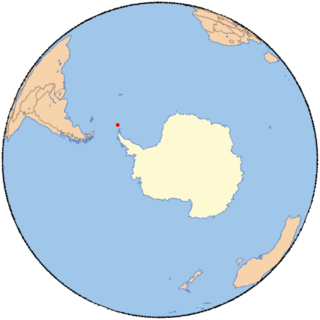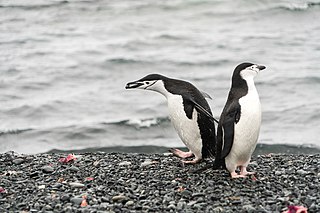
Cape Evans is a rocky cape on the west side of Ross Island, Antarctica, forming the north side of the entrance to Erebus Bay.

Shagnasty Island is a small, rocky ice-free island lying 0.3 miles (0.5 km) west of Lenton Point in the north part of Clowes Bay, close off the south coast of Signy Island in the South Orkney Islands. Roughly charted in 1933 by Discovery Investigations personnel, and surveyed in 1947 by the Falkland Islands Dependencies Survey (FIDS). The name, applied by FIDS, arose from the unpleasant state of the island due to its occupation by a large colony of blue-eyed shags.
Iceberg Bay is a bay 3 miles (5 km) wide, which indents the south coast of Coronation Island between Cape Hansen and Olivine Point, in the South Orkney Islands, Antarctica. It was named by Matthew Brisbane, who roughly charted the south coast of Coronation Island under the direction of James Weddell in 1823. Beaufoy Ridge and Sunshine Glacier lie close north of Iceberg Bay.
Laws Glacier is a confluent glacier system which flows into Marshall Bay on the south coast of Coronation Island, in the South Orkney Islands off Antarctica. It was surveyed in 1948–49 by the Falkland Islands Dependencies Survey (FIDS), and was named by the UK Antarctic Place-Names Committee for Richard M. Laws of the FIDS, leader and biologist at Signy Research Station in 1948 and 1949, and at South Georgia in 1951.
Beaufoy Ridge is a conspicuous black ridge, rising to 650 metres (2,130 ft) at its northwest end, standing at the west side of Sunshine Glacier and close north of Iceberg Bay on the south coast of Coronation Island, in the South Orkney Islands. It was named by the Falkland Islands Dependencies Survey, following their survey in 1948–49, after the cutter Beaufoy which, on 12 December 1821, under Michael McLeod, sailed to a position at least 60 nautical miles (110 km) west of the South Orkney Islands, where a chart annotation indicates that land was sighted, possibly Coronation Island.
Confusion Island is an island 0.2 nautical miles (0.4 km) long at the west side of the entrance to Clowes Bay, off the south side of Signy Island.
The Cragsman Peaks are peaks on the west side of Marshall Bay, extending from Cape Vik northwest to Coldblow Col on the south coast of Coronation Island, in the South Orkney Islands. They were surveyed by the Falkland Islands Dependencies Survey in 1956–58 and so named by the UK Antarctic Place-Names Committee because the peaks provide a "climbers' paradise."
Sunshine Glacier is a glacier, 3 nautical miles (6 km) long and 2 nautical miles (3.7 km) wide, flowing south into Iceberg Bay on the south coast of Coronation Island, in the South Orkney Islands. It is the largest glacier on the south side of Coronation Island and terminates in ice cliffs up to 60 m high. Surveyed in 1948-49 by the Falkland Islands Dependencies Survey (FIDS) and so named by them because, when all else was in shadow, small gaps in the clouds above frequently allowed patches of sunshine to appear on the surface of this glacier. At the west side of Sunshine Glacier stands the conspicuous black ridge of Beaufoy Ridge, rising to 650 metres (2,130 ft) at its northwest end.
The Fulmar Crags are crags surmounting East Cape, the northeastern extremity of Coronation Island in the South Orkney Islands. The name arose from the Antarctic fulmars which breed on these crags and was given by the UK Antarctic Place-Names Committee following a 1956–58 survey by the Falkland Islands Dependencies Survey.
Cape Faraday is a cape which forms the northern tip of Powell Island in the South Orkney Islands. It was discovered by Captain George Powell and Captain Nathaniel Palmer on the occasion of their joint cruise in December 1821. The name first appears on Powell's chart published in 1822.
Fitchie Bay is a bay lying between Cape Dundas and Cape Whitson on the south side of Laurie Island, in the South Orkney Islands. It was charted in 1903 by the Scottish National Antarctic Expedition under William Speirs Bruce, who named it for John Fitchie, second mate of the expedition ship Scotia.

Gibbon Bay is a bay 2 km (1.2 mi) long and wide, entered between Rayner Point and The Turret along the east coast of Coronation Island, in the South Orkney Islands of Antarctica. The bay was first seen in December 1821 by Captain George Powell and Captain Nathaniel Palmer, but was more accurately delineated on a 1912 chart by Captain Petter Sorlle. It was recharted in 1933 by Discovery Investigations personnel on the Discovery II and named for the ship's surgeon, Dr G.M. Gibbon.
Cape Hansen is a cape which separates Marshall Bay and Iceberg Bay on the south coast of Coronation Island, in the South Orkney Islands, Antarctica. The name appears on a chart based upon a running survey of the islands in 1912–13 by Petter Sørlle, a Norwegian whaling captain.
McLeod Glacier is a glacier 1 nautical mile (2 km) long, flowing in a southeasterly direction into Clowes Bay on the south side of Signy Island, in the South Orkney Islands off Antarctica. It was named by the UK Antarctic Place-Names Committee in 1954 for Michael McLeod, following a survey by the Falkland Islands Dependencies Survey in 1947. On 12 December 1821, the cutter Beaufoy under McLeod sailed to a position at least 60 nautical miles (110 km) west of the South Orkney Islands, where a chart annotation indicates that land was sighted, possibly Coronation Island.
Maling Peak is a mountain 430 metres (1,400 ft) high and is the southernmost of two conspicuous peaks 0.5 nautical miles (1 km) northwest of Cape Vik on the south coast of Coronation Island in the South Orkney Islands, Antarctica. It was roughly surveyed in 1933 by Discovery Investigations personnel and was named by the UK Antarctic Place-Names Committee for Derek H. Maling, a Falkland Islands Dependencies Survey meteorologist at Signy Island in 1948 and 1949, who made a survey triangulation of Signy Island and the south coast of Coronation Island.

Mansfield Point is a point marking the east side of the entrance to Norway Bight on the south coast of Coronation Island, in the South Orkney Islands, Antarctica. It was surveyed by Discovery Investigations personnel in 1933 and by the Falkland Islands Dependencies Survey (FIDS) in 1948–49. The feature was named by the UK Antarctic Place-Names Committee for Arthur W. Mansfield of the FIDS, a meteorologist at Grytviken, South Georgia, in 1951, and leader, meteorologist and biologist at Signy Island in 1952.
Rayner Point is a point marked by a rocky peak forming the north side of the entrance to Gibbon Bay on the east coast of Coronation Island, in the South Orkney Islands. Charted in 1912-13 by Captain Petter Sorlle, a Norwegian whaler. Recharted in 1933 by DI personnel on the Discovery II and named for George W. Rayner, member of the zoological staff of the Discovery Committee.

Lynch Island is an island lying in the eastern part of Marshall Bay, close off the south coast of Coronation Island in the South Orkney Islands, Antarctica.

Cape Vik is a cape marking the west side of the entrance to Marshall Bay on the south coast of Coronation Island, in the South Orkney Islands. The cape appears to be first shown and named on a chart made by the Norwegian whaler Captain Petter Sorlle in 1912–13.

Limit Rock is a rock awash, lying 2 nautical miles (4 km) east of North Foreland, the northeast cape of King George Island, in the South Shetland Islands on the Southern Ocean. It was charted in 1937 by Discovery Investigations personnel on the Discovery II, and so named because it marks the eastern limit of foul ground surrounding North Foreland.





